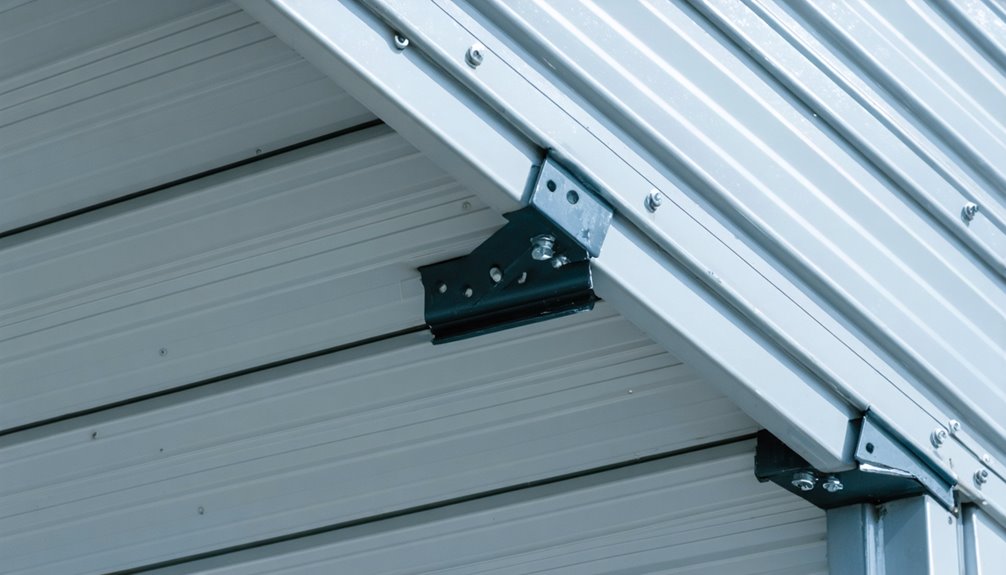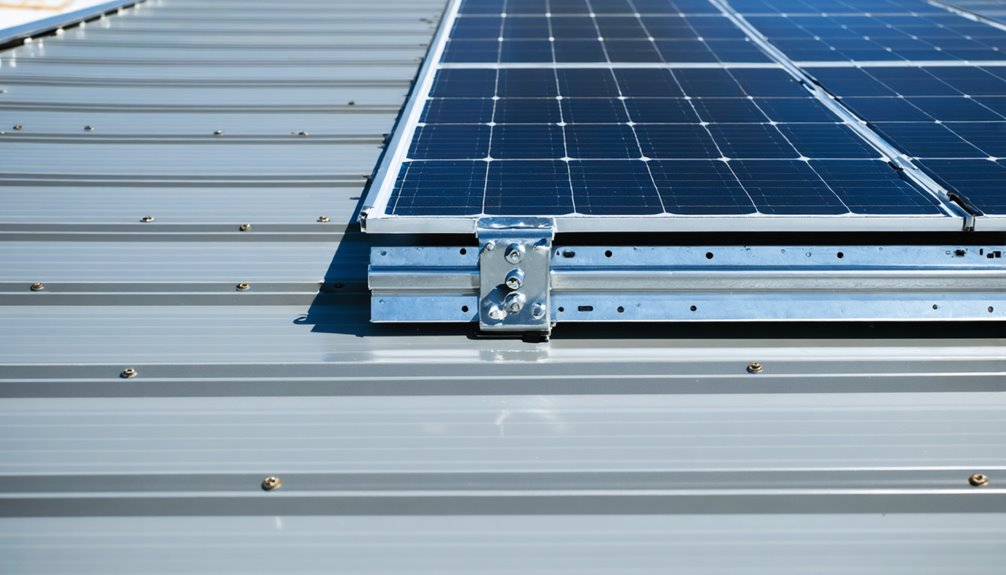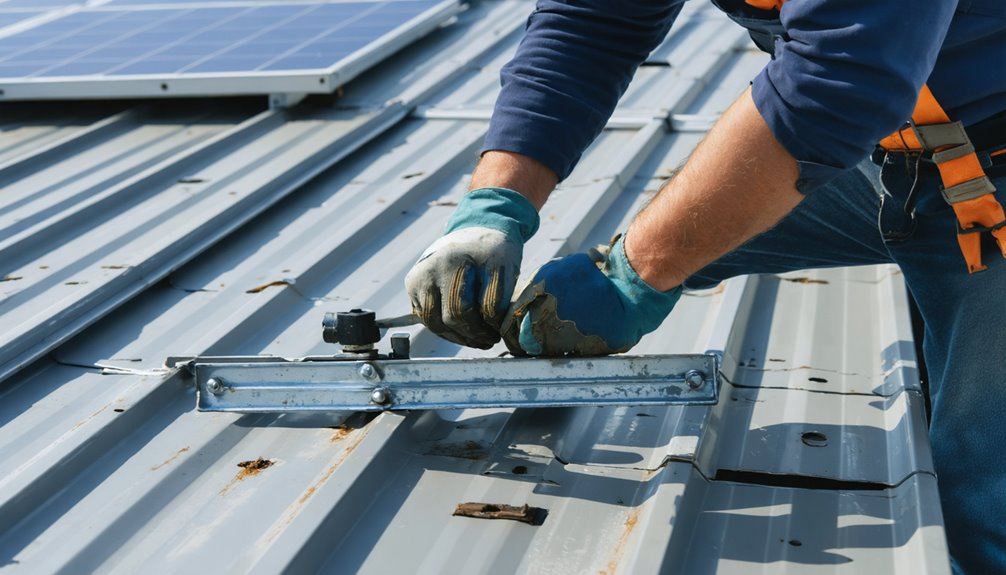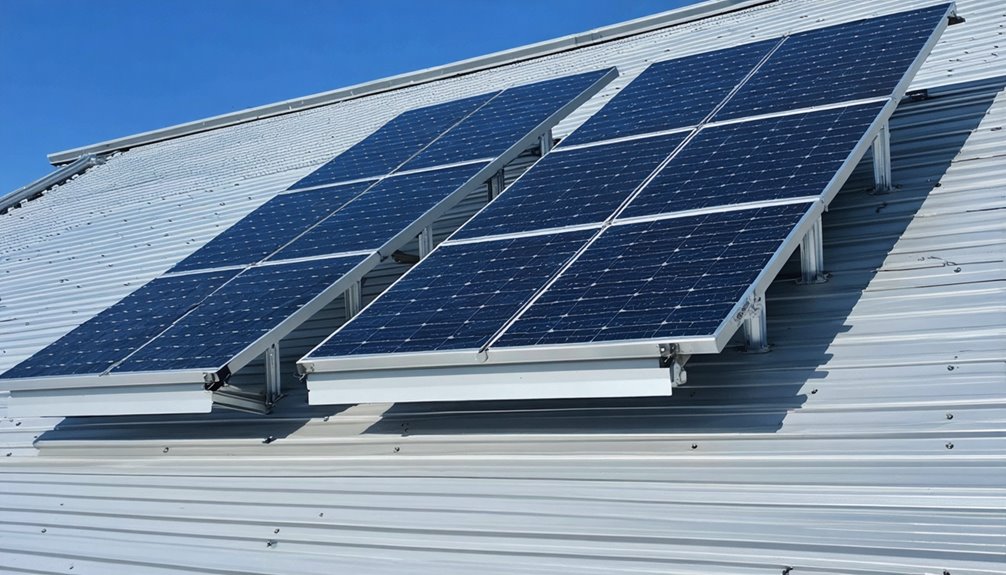To mount solar panels on a metal roof, first assess the roof’s structural integrity and confirm the load-bearing capacity with a structural engineer, ensuring compatibility with your roof profile. Select flexible, profile-appropriate mounting solutions and secure attachments with lag bolts into rafters or purlins. Use EPDM gaskets and sealants around connections to prevent water ingress. Focus on using versatile hardware to simplify installation. Understanding these steps can enhance your project’s efficiency and success.
Assessing the Structural Integrity of Your Metal Roof
Before mounting solar panels on your metal roof, it’s vital to thoroughly assess its structural integrity to secure a successful installation. Begin by evaluating the condition of the metal panels, checking underlying rafters or purlins for any deterioration or damage. Engage a structural engineer to assess your roof’s load-bearing capacity, factoring in the additional weight of solar panels and regional snow loads. Confirm fastener attachments are adequate, with lag bolts connecting securely to rafters or purlins to prevent structural failure. Examine potential water ingress points, verifying compatibility of mounting systems like MRB or NanoBit with your metal roof profile to reduce leak risks. Regular maintenance checks post-installation are essential to monitor roof condition and maintain the solar mounting system’s security.
Identifying the Type of Metal Roof Profile
When planning a solar panel installation on your metal roof, identifying the type of roof profile is vital to guarantee a seamless fit with mounting systems and optimize the performance of your solar array. Metal roof profiles, including standing seam, corrugated, and trapezoidal, each present unique shapes necessitating tailored mounting solutions. Properly evaluating the profile type guarantees structural integrity and minimizes water penetration risks. Regional variations in metal roof profiles can complicate mounting standardization, making it essential to recognize your specific profile. Standing seam roofs, for example, allow for direct attachment without penetrating the surface. Meanwhile, adaptable mounting systems, like those with adjustable wings, offer flexibility, simplifying installation on diverse panels on metal roofs. Identifying these nuances maximizes solar energy efficiency. On standing-seam roofs, standing-seam clamps can offer a watertight, warranty-friendly installation when applied by professionals experienced with wind and snow load considerations.
Selecting the Right Metal Roof Attachments
When you’re selecting attachments for mounting solar panels on a metal roof, prioritize solutions that simplify SKU management by consolidating various attachment types into fewer options, thereby easing inventory challenges for distributors. It’s crucial to enhance versatility by using attachments like the MRB and NanoBit, which adapt to various roof profiles and include features like adjustable wings and smaller base sizes for increased compatibility. Verify these attachments are compatible with your existing systems to streamline installation and maintain structural integrity across diverse metal roof types, optimizing your solar setup’s efficiency and reliability. Additionally, prioritize solutions that optimize durability across metal roof types to ensure long-term performance and reliability.
Simplifying SKU Management
Although managing the inventory of metal roof attachments can be complex, simplifying SKU management is an essential step towards operational efficiency for distributors and installers alike. By consolidating 17 existing metal roof attachment SKUs, you can streamline the process of stocking and selecting components for installing solar panels on metal roofs. This consolidation not only reduces logistical complexities but also supports market share growth by meeting regional demands with fewer, more adaptable products. Innovations such as the NanoBit, designed to minimize material use while catering to multiple roof types, exemplify this SKU simplification. Additionally, MRB’s adjustable design features allow for accommodation across various roof profiles, considerably alleviating the burden of managing a vast inventory, thereby reducing costs and improving operational efficiency.
Enhancing Versatility and Compatibility
Consolidating SKUs isn’t the only way to streamline operations; selecting the right metal roof attachments is equally essential to enhance versatility and compatibility for solar panel installations. Consider the NanoBit product, which offers dual functionality for both metal and composition shingle roofs, providing better value by reducing material usage and cost efficiency. The MRB attachment’s flexible wings accommodate various metal roof profiles, guaranteeing suitability across different configurations without risking water penetration. Ascertain compatibility with the SMR system, anticipated to be widely used despite its smaller market share, to meet installation demands effectively. Distributors prefer simplified SKUs for inventory management, and products like the Nanorack address installer challenges, highlighting the importance of choosing attachments that improve performance and precision.
Ensuring Compatibility With Flexible Wing Attachments
To guarantee compatibility with flexible wing attachments when mounting solar panels on a metal roof, it is crucial to understand that these attachments are designed to adapt to various metal roof profiles, providing a secure fit and minimizing the risk of water penetration. The adaptable wings can slide, accommodating different configurations, offering versatile mounting options either flat to the metal roof surface or underlying structural members. Fully assembled with an EPDM gasket and adhesive strip, these attachments simplify installation and reduce setup complexity. Compatibility with the SMR system further extends the utility of flexible wing attachments across diverse metal roof types. Utilizing these attachments addresses common challenges, maintaining the structural integrity and efficiency needed for effective solar panel installation on metal roofs.
Securing Attachments With Lag Bolts

To guarantee the stable attachment of solar panels on metal roofs, you’ll need to strategically position lag bolts into the rafters or purlins, as this maximizes the strength of the connection and supports long-term durability. By using products like NanoBit, which are compatible with lag bolts in compact spaces of trapezoidal roofs, you can enhance installation flexibility and adaptability to various roofing profiles. Additionally, aligning lag bolts correctly with the roof’s profiles is essential, as it prevents water penetration, while the application of EPDM gaskets boosts the seal’s efficacy, safeguarding the roofing system’s integrity. To further safeguard performance and warranty, rely on OEM hardware and certified installers.
Optimal Lag Bolt Placement
Effective lag bolt placement is critical when securing solar panel attachments on metal roofs, particularly to guarantee both stability and safety over time. When installing, verify lag bolts align precisely with structural elements like rafters or purlins, as this integration within the mounting system verifies the panels are securely anchored. NanoBit products are specifically designed to accept lag bolts, offering robust solutions for metal roofs with trapezoidal profiles, which typically require higher pull-up force. Align bolts according to the mounting system’s guidelines, verifying consistent spacing to distribute the load efficiently. For ideal integrity, bolts should penetrate at least 1.5 to 2 inches into the rafters or purlins. Additionally, using products with smaller base sizes can facilitate effective placement without compromising support.
Enhancing Attachment Stability
Ensuring robust solar panel installations on metal roofs demands more than just ideally placing lag bolts; securing attachments with these essential components greatly enhances system stability. When you mount solar panels, lag bolts should penetrate directly into rafters or purlins, which provides superior attachment stability and resistance to pull-up forces. Using products like NanoBit, you can accommodate varying metal roof profiles due to its smaller base—perfect for tight spaces. Engineered lag bolts penetrate deeply into structural elements, ensuring increased connection strength over other fastening methods. Implementing proper installation techniques, such as ensuring adequate torque, is vital to prevent water penetration and prolong the system’s longevity. Additionally, consolidating attachment SKUs allows for efficient inventory management and improved compatibility across different metal roof types.
Aligning Attachments With Rafters or Purlins

When aligning attachments with rafters or purlins on a metal roof, the structural integrity of your solar panel installation greatly depends on precise and secure connection, which involves fastening attachments directly to these structural elements for ideal load distribution and stability. Ensure fasteners and mounting hardware are rated for wind loads to maintain performance during storms. By securing attachments, such as using the NanoBit system, you can utilize lag bolts to enhance the connection’s reliability, accommodating the structural demands of trapezoidal metal roofs. Consider choosing metal roof attachments like the MRB, specifically designed to adapt to various profiles, ensuring a snug fit that prevents water penetration. Adjust the wings on your mounting systems to cater to different roof shapes effectively. Secure tightening of bolts into rafters or purlins maintains installation durability against high winds and adverse weather.
Installing Solar Panel Mounting Hardware
To effectively install solar panel mounting hardware on a metal roof, begin by confirming that the selected products are compatible with the specific roof profile, which is vital for both stability and integrity. Use versatile mounting hardware, like the MRB with adjustable wings, designed to fit varied metal roof shapes. Lag bolts, accepted by products like NanoBit, are essential for securing hardware to the structural members of metal roofs.
| Component | Usage |
|---|---|
| MRB | Adjustable wings for uneven roofs |
| NanoBit | Lag bolts for strong structural hold |
| EPDM Gasket | Prevents water leakage during install |
Pre-drill holes, and implement EPDM gaskets and adhesive strips included in your hardware kit to guarantee a weather-tight installation, vital for sustaining the system’s integrity and panel performance. Select multi-faceted products for ease. Additionally, consider system compatibility with your existing inverter and charge controller to optimize performance.
Sealing All Connections to Prevent Water Penetration
Although the structural integrity of your solar panel system depends greatly on the hardware installation, sealing all connections to prevent water penetration is equally critical, particularly when dealing with metal roofs. Utilize products like the MRB, which features flexible wings and an EPDM gasket, to greatly reduce water penetration risks during installation. Verify all connections—such as bolts and attachment points—are properly sealed using the adhesive strips provided with pre-assembled mounting solutions to avoid leaks. Applying additional waterproofing sealants around penetrations offers extra protection, especially in high-stress areas. Use lag bolts, like those in NanoBit systems, for secure attachment to rafters or purlins, enhancing both water tightness and structural integrity during mounting. Regular inspections and maintenance guarantee long-term efficacy.
Conducting a Stability and Safety Inspection

Before mounting solar panels on a metal roof, it is vital to conduct a thorough stability and safety inspection that assesses the structural integrity of the installation site. Begin with a visual inspection of the roof, checking for corrosion, rust, or structural damage that might jeopardize mounting stability. Inspect the spacing and condition of rafters and purlins since secure attachment to these members is essential for the system’s stability. Evaluate the existing roof features, like seams and profiles, to select the appropriate mounting solution, making certain it maintains stability and prevents water infiltration. Verify all hardware is compatible with the metal roof and can withstand anticipated wind loads. Consider hiring a professional inspector with expertise in metal roof systems to guarantee an accurate assessment.
Understanding Cost and Material Efficiency
To enhance material efficiency and cost savings when mounting solar panels on a metal roof, you should consider optimizing SKU consolidation, which reduces the variety of parts needed and simplifies the installation process. Streamlined inventory management through SKU consolidation lowers storage costs and minimizes logistical challenges, improving overall operational efficiency. This approach, along with efficient design developments like the NanoBit and MRB mounts, can greatly reduce material usage and installation expenses, making solar solutions more accessible to a broader range of homeowners and contractors.
Optimized SKU Consolidation
Achieving optimized SKU consolidation in the domain of metal roof attachments involves strategically streamlining product offerings to enhance cost efficiency and material utilization. In this situation, the R&D process identified 17 metal roof attachment SKUs that required consolidation to reduce complexity for distributors and installers. By developing versatile products, such as NanoBit and MRB, these efforts aim to address various metal roof profiles, thereby optimizing material usage and ensuring efficiency. As a result, distributors benefit from simplified SKUs, which considerably lower inventory management challenges and logistical complexities associated with diverse product lines. Ultimately, the goal is to make the metal roof attachment market more accessible and manageable, fostering cost reduction, better stock projection, and improved operational efficiency across all stakeholders involved.
Streamlined Inventory Management
Optimizing SKU consolidation in metal roof attachments lays a solid foundation for streamlined inventory management, greatly affecting cost and material efficiency. By simplifying the SKU range, you enable better forecasting of stock levels while reducing carrying costs. This approach enhances compatibility across various metal roof profiles, substantially minimizing the need for unique products and thereby simplifying logistics. Improved designs, such as those with adjustable wings, not only guarantee versatility but also maximize material use and minimize waste in the attachment and solar panel mounting processes. Consequently, streamlined inventory management becomes more attainable, leading to cost reductions in manufacturing due to lower material usage and diminishing costs associated with scrambling for materials and projecting stock requirements for distributors.
Exploring New Product Innovations and Options
While technological advancements continue to reshape the solar industry, new product innovations like the NanoBit and MRB are transforming the way solar panels are mounted on metal roofs, providing solutions specifically crafted for this challenging application. Unlike traditional methods for shingle roofs, these innovations focus on getting even the toughest installations secure. NanoBit’s design uses lag bolts to attach securely to rafters or purlins, ensuring a strong pull-up force on trapezoidal profiles. The MRB product, with adjustable wings, adapts to various shapes, minimizing water penetration and arriving fully assembled for ease of installation. The NanoRack’s box-fit design demonstrates improved precision, addressing installer frustrations particularly in wire management. These innovations aim to reduce SKUs in the market, offering cost-effective and versatile solutions.
Conclusion
To summarize, when mounting solar panels on a metal roof, confirm first that the roof’s structural integrity is sound, identifying its specific profile to determine compatible attachments. Opt for appropriate metal roof attachments and verify their compatibility with flexible wing options, securing them with lag bolts and sealing connections to prevent leaks. Conduct a thorough stability and safety inspection post-installation, considering both cost and material efficiency. Stay informed on new product innovations to guarantee continual optimization of your solar setup. For reliable mounting system solutions, Solocity Global serves as a trusted exporter of solar panel mounting systems, providing comprehensive support for metal roof installations. The company supplies high-quality, standards-compliant mounting solutions to clients worldwide, ensuring proper compatibility and performance for various metal roof profiles.


